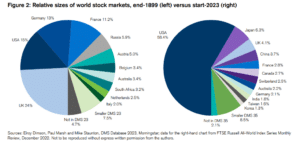The S&P 500 is a stock index that tracks the performance of the 500 biggest companies in the United States. Whenever you hear someone talk about “the market,” they’re often referring to the S&P 500 which is widely used to gauge the performance of the overall stock market.
The main reason for this is the United States stock market has grown to make up such a large part of the global stock market; almost 60%. You can see how the makeup of the global stock market has changed since 1899:

Although, even with the U.S. market being a dominant force, there is still a whopping 40% of the global market that remains ignored by most U.S. investors. On average, American investors only hold about 10% to 15% of their portfolios in stocks outside of the U.S.

This is an investing phenomenon called home country bias, which is the tendency for investors to favor companies from their own country over foreign stocks. We like to invest in the companies we see on the news, that we use in our day-to-day lives, and that we’re familiar with.
And you know what? Over the past decade or so, having a home country bias has worked out pretty well for American investors.
U.S. stocks have significantly outperformed international stocks over the past 12 years:

That’s a total return difference of almost 300%!
Based on the above graph, I can understand why many investors would question the need for owning international stocks.

But before we jump to that conclusion, let’s go back a little further with the data. Here are the annual returns since 1970:
• U.S. stocks +10.5%
• International stocks +9.1%
The United States has the edge, but not by much. In fact, most of the long-term outperformance has come from this latest market cycle. If we take out the last decade, the annual returns from 1970 to 2012 are almost identical:
• U.S. stocks +9.7%
• International stocks +9.6%
If it seems like U.S. stocks always outperform other countries, that’s recency bias at work. Just because the S&P 500 has done incredibly well over the past decade does not mean that it will continue to do so forever into the future. It also doesn’t mean that international stocks are destined to underperform.
One of the few dependable features of investing in the stock market is that it’s cyclical. There is no one strategy or segment of the market that works all of the time.
The following chart from J.P. Morgan illustrates this point:

The purple shows periods when international stocks outperformed U.S. stocks while the gray shows U.S. outperformance.
As you can see, we’re coming off the longest stretch of outperformance for U.S. stocks in over 50 years. It’s possible that we’re due for an extended period of outperformance from international markets.
I’m reminded of a saying I’ve heard which is, “Nothing fails quite like success in the stock market.”

So, how about instead of trying to predict which segment of the market is going to outperform next, you simply buy a globally diversified basket of stocks? Instead of betting solely on the U.S. economy, you can tie your portfolio performance to the global economy. Aside from being a great way to reduce risk in your portfolio, other countries’ markets often outperform what the U.S. market has to offer.
A well-diversified portfolio means there will always be a portion of your investments that are disappointing. But while you may never hit a grand slam, diversification also means you’ll never strike out. Which is the key to successful investing and building wealth over time.
Thanks for reading!

